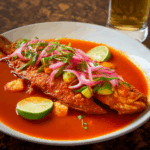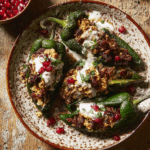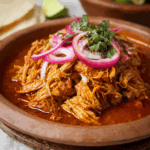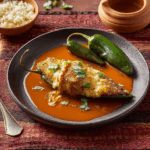The warmth of North African spices meets tender chicken in this Moroccan Chicken Tagine, a dish brimming with citrusy preserved lemon, briny green olives, and golden saffron. Slow-braised to perfection, every bite delivers layers of bold, aromatic flavors that transport your taste buds straight to Marrakesh.
Perfect for an intimate dinner or a feast with friends, this recipe is both rustic and elegant. Its balance of spice, acidity, and richness is a masterclass in Moroccan cooking. Serve it over fluffy couscous or warm flatbread to soak up every last drop of the luscious sauce. Once you try it, you’ll keep coming back for more.
Full Recipe:
-
1/4 teaspoon saffron threads
-
1 1/2 cups hot chicken broth or water
-
1 preserved lemon, quartered
-
6 bone-in, skin-on chicken thighs
-
4 cloves garlic, finely minced
-
1 teaspoon salt
-
1/2 teaspoon ground black pepper
-
1 teaspoon paprika
-
1 teaspoon ground cumin
-
1 teaspoon ground ginger
-
1/2 teaspoon Aleppo chili flakes
-
1/4 cup chopped fresh parsley
-
1/4 cup chopped fresh cilantro
-
1/4 cup olive oil (plus 2 tablespoons for cooking)
-
1 medium onion, sliced
-
1/2 teaspoon ground cinnamon
-
1/2 teaspoon ground turmeric
-
1/2 cup green olives, pitted
-
Additional parsley, cilantro, and chili flakes for garnish
Directions:
-
Combine saffron threads and hot broth in a small bowl; let steep for 20–30 minutes until cooled.
-
Separate preserved lemon peel from flesh. Finely chop the flesh and set aside. Slice the peel into 8 strips and reserve.
-
Make two cuts through the skin side of each chicken thigh. Place chicken in a large resealable bag inside a bowl.
-
In a bowl, whisk together lemon flesh, garlic, salt, pepper, paprika, cumin, ginger, chili flakes, parsley, cilantro, olive oil, and saffron liquid.
-
Pour marinade into the bag, seal, and massage thoroughly. Refrigerate for 3 to 12 hours, occasionally turning the bag.
-
Remove chicken, reserving excess marinade.
-
Heat 2 tbsp olive oil in a braising pan over medium-high. Brown chicken skin-side down for 5 minutes, then set aside.
-
In the same pan, cook onion, cinnamon, turmeric, and a pinch of salt for 2–3 minutes.
-
Return chicken to pan skin-side up. Pour in reserved marinade. Once juices bubble, cover and simmer on low for 1 hour.
-
Uncover, baste chicken, and add olives and lemon peel. Baste again and cook covered for another 15–20 minutes.
-
Raise heat to medium-high and reduce sauce to desired consistency, about 5 minutes.
-
Garnish with parsley, cilantro sprigs, and chili flakes before serving.
Prep Time: 20 minutes | Marinating Time: 3–12 hours | Cooking Time: 1 hour 30 minutes | Total Time: 2–14 hours
Kcal: 420 kcal | Servings: 4
The Allure of Moroccan Chicken Tagine
Moroccan Chicken Tagine is more than just a dish; it’s a cultural experience steeped in centuries of tradition, bursting with warm spices, bright citrus, and savory undertones. While its name comes from the traditional clay pot it’s often cooked in, the dish has evolved to be just as flavorful even when made in a standard braising pan. With its combination of preserved lemons, green olives, saffron, and a medley of North African spices, Moroccan Chicken Tagine has earned a special place in the hearts of global food lovers and home cooks alike.
A Culinary Window into Moroccan Culture
Food in Morocco is deeply tied to its heritage, and the tagine stands as a symbol of hospitality and warmth. It’s common to find this dish being served during family gatherings, religious holidays, or festive occasions. The flavors encapsulate Morocco’s long-standing trade history, showcasing ingredients like saffron, cumin, turmeric, and preserved lemons—many of which made their way into the cuisine through ancient spice routes.
The dish’s appeal lies in its depth of flavor and versatility. Despite its luxurious taste, it’s made using humble ingredients—chicken, spices, onions, and lemons—transformed into something extraordinary through slow cooking and time-honored techniques.
Not Just a Pot: The Story Behind the Tagine
Traditionally, the tagine is both the name of the dish and the conical clay pot it’s cooked in. The unique design of the tagine pot allows steam to circulate during cooking, keeping the meat incredibly tender and the sauce rich and infused with spice. Though the recipe discussed here isn’t cooked in an actual tagine pot, it captures all the authentic flavors that define this iconic Moroccan stew.
Modern kitchens may lack a traditional clay tagine, but that doesn’t mean the dish can’t be replicated. Braising pans, Dutch ovens, or any heavy-lidded pot can mimic the steam-locking properties essential to developing the dish’s signature taste and texture.
Flavor Profile: A Symphony of Sweet, Savory, and Tangy
One bite of Moroccan Chicken Tagine tells a story. The chicken is rich and tender, infused with the warmth of cinnamon, the earthiness of turmeric, the slight heat of Aleppo pepper, and the brightness of preserved lemon. Olives add a briny depth, while saffron delivers subtle floral notes and a golden hue.
It’s the harmony of sweet, savory, and tangy that makes this dish so beloved. Each element plays its part without overpowering the others. The sauce, slow-simmered and often thickened to a glaze-like consistency, clings lovingly to every piece of chicken, ensuring maximum flavor in every bite.
Preserved Lemons: The Secret Star
If there’s one ingredient that truly defines Moroccan Chicken Tagine, it’s preserved lemon. Unlike fresh lemons, preserved lemons are aged in salt and their own juices, creating a deeply tangy, umami-packed ingredient that permeates the dish with flavor. Their rind is used more than the pulp and is typically sliced thinly or minced and incorporated into the marinade or sauce.
Preserved lemons are a pantry staple in Moroccan homes and are responsible for giving the tagine its unmistakable citrus punch. They’re easy to make at home but are also widely available in international grocery stores.
Health Benefits and Nutritional Highlights
Despite its rich taste, Moroccan Chicken Tagine is surprisingly nutritious. It’s high in protein from the chicken, and many of its spices—such as turmeric, ginger, and cumin—are known for their anti-inflammatory and digestive benefits. The olives add heart-healthy fats, while the preserved lemons offer a boost of vitamin C and beneficial probiotics.
It’s also a great dish for those following the Mediterranean diet, which emphasizes whole foods, healthy fats, and lean proteins. Plus, the recipe is naturally gluten-free and can be easily adapted for low-carb or paleo diets by serving it with cauliflower rice or leafy greens instead of couscous or bread.
Perfect Pairings for the Ultimate Experience
To fully enjoy Moroccan Chicken Tagine, it’s best served with something to soak up all that incredible sauce. Traditional accompaniments include fluffy couscous, warm flatbread, or rice. If you want to elevate the experience further, consider pairing it with a side of grilled vegetables or a Moroccan carrot salad flavored with cumin and lemon.
For drinks, a mint tea provides a refreshing contrast to the richness of the dish, while a light white wine or citrus-infused sparkling water can enhance the overall dining experience.
Tips for Maximum Flavor
-
Marinate Ahead: Letting the chicken marinate for several hours—or ideally overnight—allows the spices and lemon to deeply penetrate the meat, resulting in maximum flavor.
-
Use Bone-In, Skin-On Chicken: This not only adds flavor but also keeps the meat moist during the slow cooking process.
-
Don’t Rush the Cooking: The magic of this dish lies in its slow braise. Low and slow cooking ensures that all the flavors meld together and the chicken becomes fall-off-the-bone tender.
-
Garnish Generously: Fresh parsley or cilantro, a sprinkle of chili flakes, and even toasted almonds can add a wonderful finish in both taste and presentation.
Variations and Customizations
While this version sticks closely to tradition, Moroccan Chicken Tagine is incredibly adaptable:
-
Add dried fruits like apricots or golden raisins for a hint of sweetness.
-
Swap chicken thighs for drumsticks or a whole chicken cut into parts for variety.
-
Include vegetables like carrots, potatoes, or zucchini to bulk up the meal.
-
Make it vegetarian by replacing chicken with chickpeas and root vegetables, and enhancing the spice profile accordingly.
These tweaks make the dish more customizable for dietary needs, family preferences, or simply to make use of what’s already in your pantry.
Cultural Significance and Hospitality
In Morocco, food is an expression of love and generosity. Sharing a tagine is more than just eating; it’s about coming together around a communal dish, often scooped up with pieces of bread and enjoyed in the warmth of friends and family. Meals like this one are meant to be savored slowly, with plenty of conversation and laughter.
This sense of hospitality and community is perhaps one of the most beautiful aspects of Moroccan cooking, and a big reason why dishes like chicken tagine continue to capture the hearts of people all over the world.
Conclusion: A Dish That Transcends Borders
Moroccan Chicken Tagine is not only a recipe—it’s a cultural bridge. It combines tradition, flavor, and nutrition in a way that makes it both comforting and adventurous. Whether you’re cooking it for a special occasion or simply to bring something different to your dinner table, this dish offers a unique opportunity to explore Moroccan flavors without leaving your kitchen.
It’s a reminder that food has the power to tell stories, connect people, and celebrate heritage. With its bold flavors, nourishing ingredients, and irresistible aroma, Moroccan Chicken Tagine is a culinary journey worth taking—again and again.








